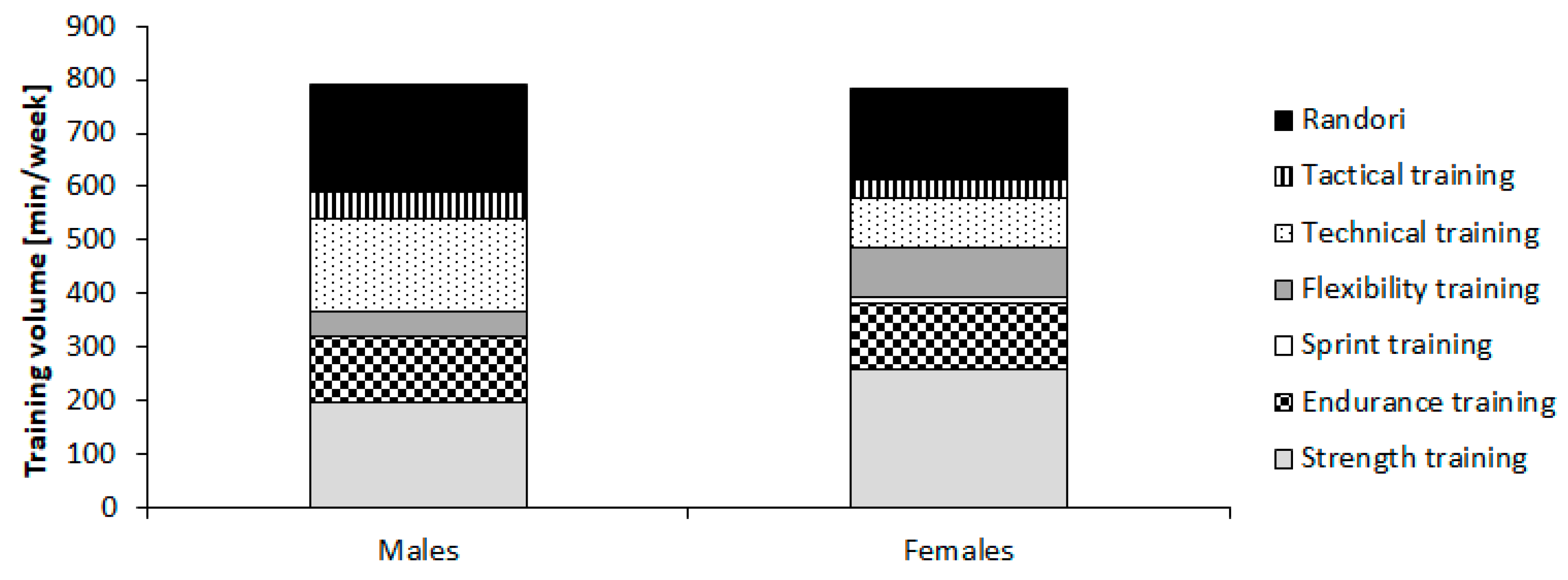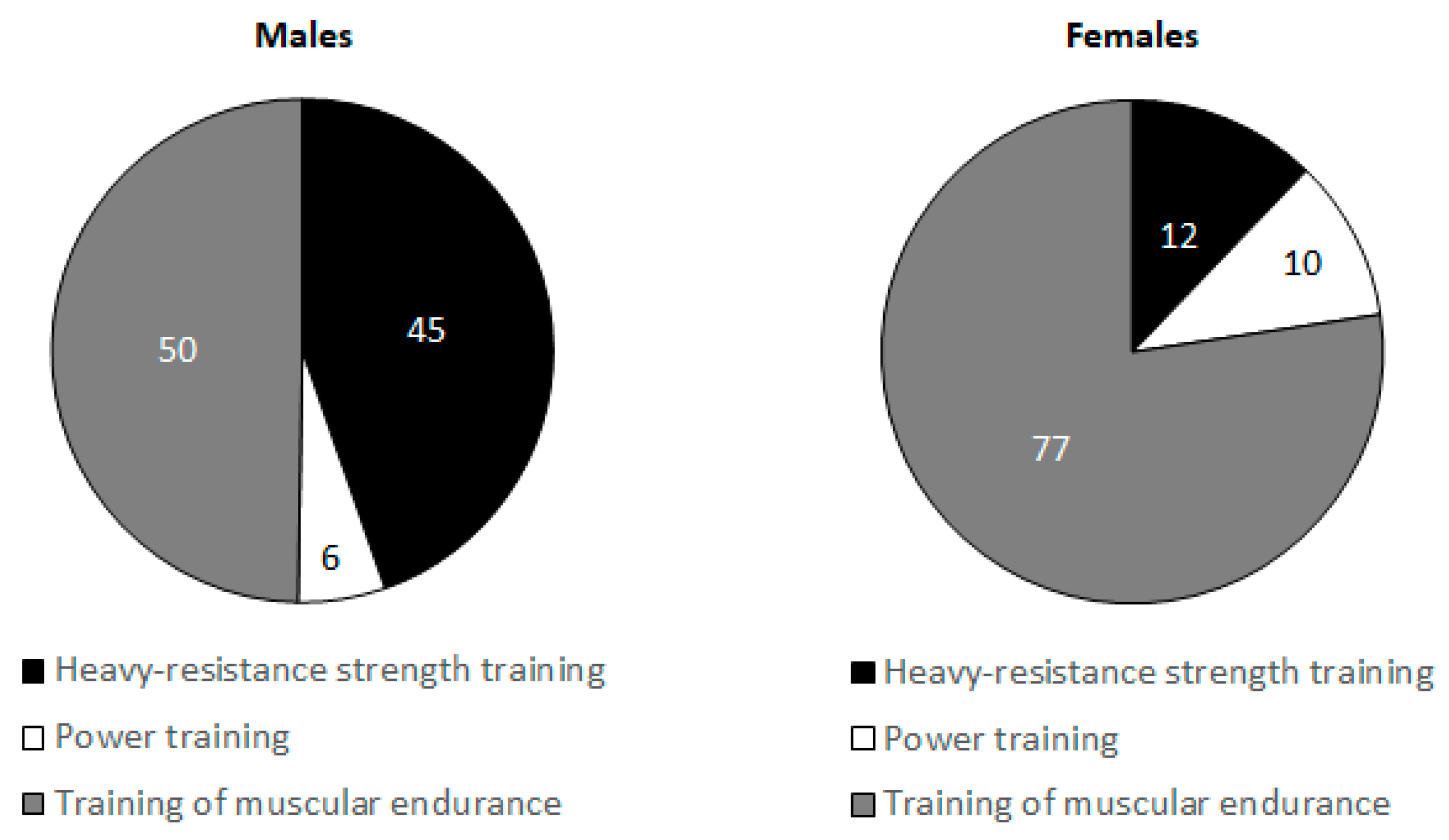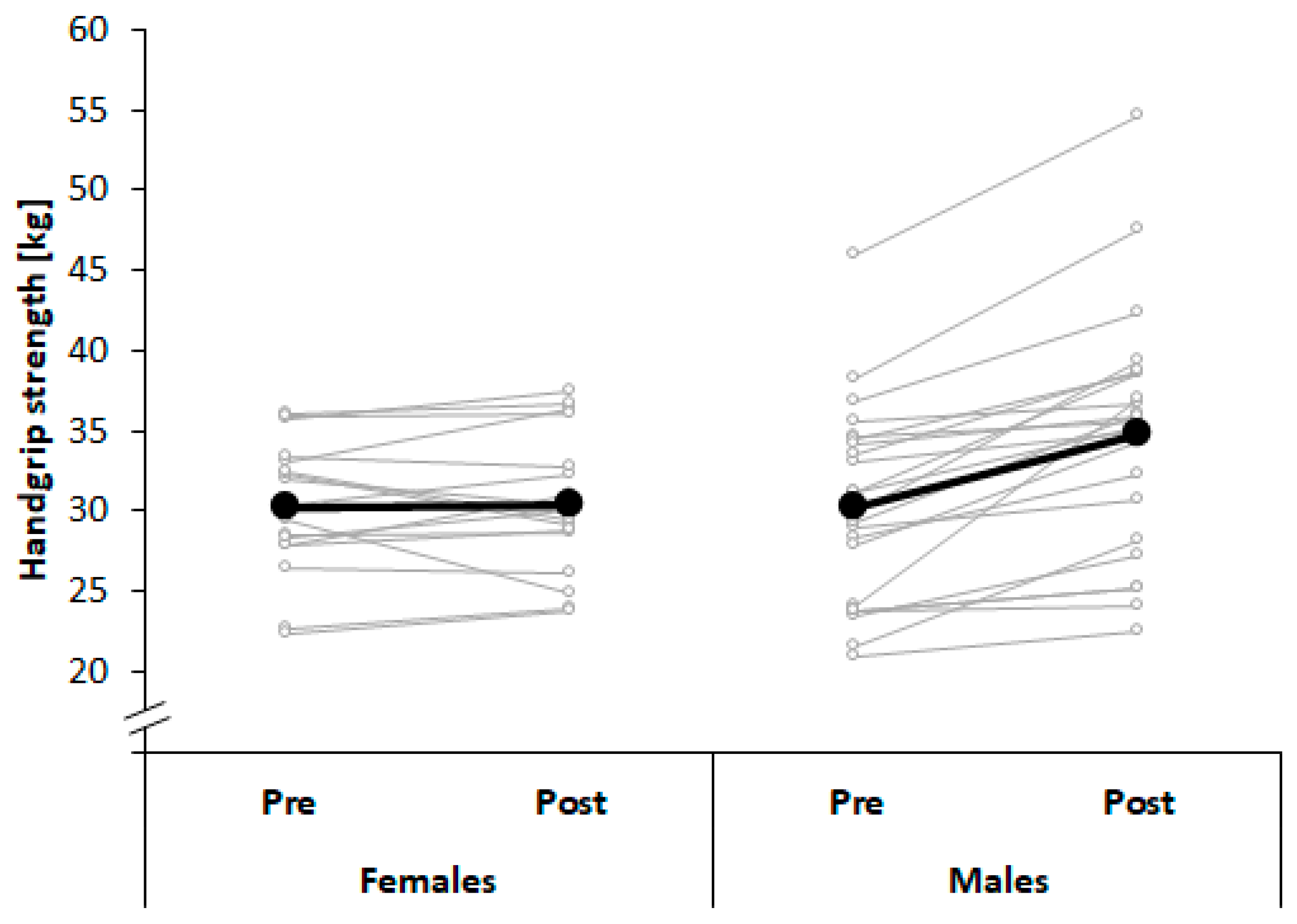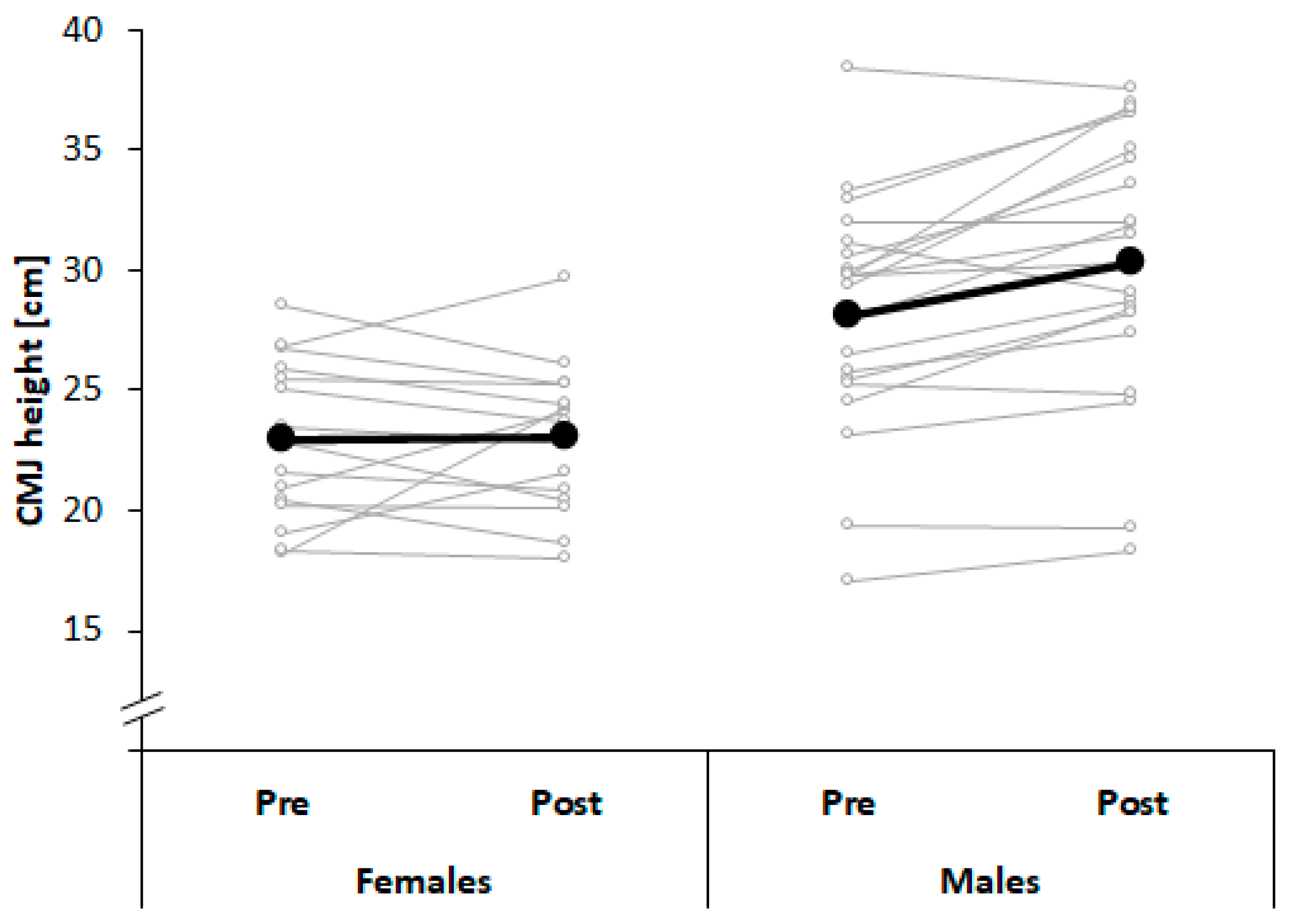Seasonal Changes in Anthropometry, Body Composition, and Physical Fitness and the Relationships with Sporting Success in Young Sub-Elite Judo Athletes: An Exploratory Study
Abstract
1. Introduction
2. Materials and Methods
2.1. Design and Procedures
2.2. Participants
2.3. Assessment of Anthropometry and Body Composition
2.4. Assessment of Physical Fitness
2.4.1. Maximal Strength
2.4.2. Vertical Jump Performance
2.4.3. Dynamic Balance
2.5. Monitoring of Training and Competition Data
2.6. Statistical Analyses
3. Results
3.1. Training Data and Sporting Success
3.2. Anthropometry and Body Composition
3.3. Physical Fitness
3.4. Associations between Seasonal Changes in Anthropometry, Body Composition, and Physical Fitness with Sporting Success
4. Discussion
4.1. Anthropometry and Body Composition
4.2. Measures of Physical Fitness
4.3. Associations of Seasonal Changes in Anthropometry, Body Composition, and Physical Fitness with Sporting Success
4.4. Limitations
5. Conclusions
Author Contributions
Funding
Acknowledgments
Conflicts of Interest
References
- Akoto, R.; Lambert, C.; Balke, M.; Bouillon, B.; Frosch, K.H.; Hoher, J. Epidemiology of injuries in judo: A cross-sectional survey of severe injuries based on time loss and reduction in sporting level. Br. J. Sports Med. 2018, 52, 1109–1115. [Google Scholar] [CrossRef] [PubMed]
- Chaabene, H.; Negra, Y.; Bouguezzi, R.; Capranica, L.; Franchini, E.; Prieske, O.; Hbacha, H.; Granacher, U. Tests for the Assessment of Sport-Specific Performance in Olympic Combat Sports: A Systematic Review With Practical Recommendations. Front. Physiol. 2018, 9, 386. [Google Scholar] [CrossRef]
- Franchini, E.; Del Vecchio, F.B.; Matsushigue, K.A.; Artioli, G.G. Physiological profiles of elite judo athletes. Sports Med. (Auckl. N. Z.) 2011, 41, 147–166. [Google Scholar] [CrossRef]
- Detailed Explanation of the IJF Judo Refereeing Rules Effective from 01 January 2018. Available online: https://www.ijf.org/news/show/detailed-explanation-of-the-ijf-judo-refereeing-rules (accessed on 22 June 2020).
- Franchini, E.; Brito, C.J.; Fukuda, D.H.; Artioli, G.G. The physiology of judo-specific training modalities. J. Strength Cond. Res. 2014, 28, 1474–1481. [Google Scholar] [CrossRef] [PubMed]
- Drid, P.; Casals, C.; Mekic, A.; Radjo, I.; Stojanovic, M.; Ostojic, S.M. Fitness and anthropometric profiles of international vs. national judo medalists in half-heavyweight category. J. Strength Cond. Res. 2015, 29, 2115–2121. [Google Scholar] [CrossRef]
- Kim, J.; Cho, H.C.; Jung, H.S.; Yoon, J.D. Influence of performance level on anaerobic power and body composition in elite male judoists. J. Strength Cond. Res. 2011, 25, 1346–1354. [Google Scholar] [CrossRef] [PubMed]
- Bourdon, P.C.; Cardinale, M.; Murray, A.; Gastin, P.; Kellmann, M.; Varley, M.C.; Gabbett, T.J.; Coutts, A.J.; Burgess, D.J.; Gregson, W.; et al. Monitoring Athlete Training Loads: Consensus Statement. Int. J. Sports Physiol. Perform. 2017, 12, S2161–S2170. [Google Scholar] [CrossRef]
- Lloyd, R.S.; Oliver, J.L.; Faigenbaum, A.D.; Howard, R.; De Ste Croix, M.B.; Williams, C.A.; Best, T.M.; Alvar, B.A.; Micheli, L.J.; Thomas, D.P.; et al. Long-term athletic development-part 1: A pathway for all youth. J. Strength Cond. Res. 2015, 29, 1439–1450. [Google Scholar] [CrossRef]
- Detanico, D.; Kons, R.L.; Fukuda, D.H.; Teixeira, A.S. Physical Performance in Young Judo Athletes: Influence of Somatic Maturation, Growth and Training Experience. Res. Q. Exerc. Sport 2020, 1–8. [Google Scholar] [CrossRef]
- Ullrich, B.; Pelzer, T.; Oliveira, S.; Pfeiffer, M. Neuromuscular Responses to Short-Term Resistance Training With Traditional and Daily Undulating Periodization in Adolescent Elite Judoka. J. Strength Cond. Res. 2016, 30, 2083–2099. [Google Scholar] [CrossRef]
- Franchini, E.; Branco, B.M.; Agostinho, M.F.; Calmet, M.; Candau, R. Influence of linear and undulating strength periodization on physical fitness, physiological, and performance responses to simulated judo matches. J. Strength Cond. Res. 2015, 29, 358–367. [Google Scholar] [CrossRef]
- Zauner, C.W.; Maksud, M.G.; Melichna, J. Physiological considerations in training young athletes. Sports Med. (Auckl. N.Z.) 1989, 8, 15–31. [Google Scholar] [CrossRef]
- McManus, A.M.; Armstrong, N. Physiology of elite young female athletes. Med. Sport Sci. 2011, 56, 23–46. [Google Scholar] [CrossRef]
- Balyi, I.; Way, R.; Higgs, C. Long-Term Athlete Development; Human Kinetics: Champaign, IL, USA, 2013. [Google Scholar]
- Wind, A.E.; Takken, T.; Helders, P.J.M.; Engelbert, R.H.H. Is grip strength a predictor for total muscle strength in healthy children, adolescents, and young adults? Eur. J. Pediatrics 2010, 169, 281–287. [Google Scholar] [CrossRef] [PubMed]
- Markovic, G.; Dizdar, D.; Jukic, I.; Cardinale, M. Reliability and factorial validity of squat and countermovement jump tests. J. Strength Cond. Res. 2004, 18, 551–555. [Google Scholar] [CrossRef] [PubMed]
- Schwiertz, G.; Brueckner, D.; Schedler, S.; Kiss, R.; Muehlbauer, T. Performance and reliability of the Lower Quarter Y Balance Test in healthy adolescents from grade 6 to 11. Gait. Posture 2019, 67, 142–146. [Google Scholar] [CrossRef] [PubMed]
- Mirwald, R.L.; Baxter-Jones, A.D.; Bailey, D.A.; Beunen, G.P. An assessment of maturity from anthropometric measurements. Med. Sci. Sports Exerc. 2002, 34, 689–694. [Google Scholar]
- Chaabene, H.; Negra, Y.; Bouguezzi, R.; Mkaouer, B.; Franchini, E.; Julio, U.; Hachana, Y. Physical and Physiological Attributes of Wrestlers: An Update. J. Strength Cond. Res. 2017, 31, 1411–1442. [Google Scholar] [CrossRef]
- McLester, C.N.; Nickerson, B.S.; Kliszczewicz, B.M.; McLester, J.R. Reliability and Agreement of Various InBody Body Composition Analyzers as Compared to Dual-Energy X-ray Absorptiometry in Healthy Men and Women. J. Clin. Densitom. Off. J. Int. Soc. Clin. Densitom. 2018, 23, 443–450. [Google Scholar] [CrossRef]
- Gerodimos, V. Reliability of handgrip strength test in basketball players. J. Hum. Kinet. 2012, 31, 25–36. [Google Scholar] [CrossRef]
- Coren, S. The lateral preference inventory for measurement of handedness, footedness, eyedness, and earedness: Norms for young adults. Bull. Psychon. Soc. 1993, 31, 1–3. [Google Scholar] [CrossRef]
- Glatthorn, J.F.; Gouge, S.; Nussbaumer, S.; Stauffacher, S.; Impellizzeri, F.M.; Maffiuletti, N.A. Validity and reliability of Optojump photoelectric cells for estimating vertical jump height. J. Strength Cond. Res. 2011, 25, 556–560. [Google Scholar] [CrossRef] [PubMed]
- Kibele, A. Technical note. Possible errors in the comparative evaluation of drop jumps from different heights. Ergonomics 1999, 42, 1011–1014. [Google Scholar] [CrossRef]
- Prieske, O.; Muehlbauer, T.; Krueger, T.; Kibele, A.; Behm, D.; Granacher, U. Sex-specific effects of surface instability on drop jump and landing biomechanics. Int. J. Sports Med. 2015, 36, 75–81. [Google Scholar] [CrossRef] [PubMed]
- Filipa, A.; Byrnes, R.; Paterno, M.V.; Myer, G.D.; Hewett, T.E. Neuromuscular training improves performance on the star excursion balance test in young female athletes. J. Orthop. Sports Phys. Ther. 2010, 40, 551–558. [Google Scholar] [CrossRef]
- Plisky, P.J.; Rauh, M.J.; Kaminski, T.W.; Underwood, F.B. Star Excursion Balance Test as a predictor of lower extremity injury in high school basketball players. J. Orthop. Sports Phys. Ther. 2006, 36, 911–919. [Google Scholar] [CrossRef] [PubMed]
- Sipe, C.L.; Ramey, K.D.; Plisky, P.P.; Taylor, J.D. Y-Balance Test: A Valid and Reliable Assessment in Older Adults. J. Aging and Phys. Act. 2019, 27, 663. [Google Scholar] [CrossRef]
- Bastien, M.; Moffet, H.; Bouyer, L.; Perron, M.; Hébert, L.J.; Leblond, J. Concurrent and discriminant validity of the Star Excursion Balance Test for military personnel with lateral ankle sprain. J. Sport Rehabil. 2014, 23, 44–55. [Google Scholar] [CrossRef]
- Büsch, D.H.; Rebel, M.; Wendt, R.; Horn, A.; Granacher, U. One year PotAS Commission- Objectives, tasks, and current state. Leistungssport 2018, 48, 4–9. [Google Scholar]
- Cohen, J. Statistical Power Analysis for the Behavioral Sciences; Erlbaum: Hillsdale, MI, USA, 1988. [Google Scholar]
- Torres-Luque, G.; Hernández-García, R.; Escobar-Molina, R.; Garatachea, N.; Nikolaidis, P.T. Physical and Physiological Characteristics of Judo Athletes: An Update. Sports 2016, 4, 20. [Google Scholar] [CrossRef]
- Casals, C.; Huertas, J.R.; Franchini, E.; Sterkowicz-Przybycień, K.; Sterkowicz, S.; Gutiérrez-García, C.; Escobar-Molina, R. Special Judo Fitness Test Level and Anthropometric Profile of Elite Spanish Judo Athletes. J. Strength Cond. Res. 2017, 31, 1229–1235. [Google Scholar] [CrossRef] [PubMed]
- Franchini, E.; Takito, M.; Kiss, M.; Strerkowicz, S. Physical fitness and anthropometrical differences between elite and non-elite judo players. Biol. Sport 2005, 22, 315. [Google Scholar]
- Little, N. Physical performance attributes of junior and senior women, juvenile, junior, and senior men judokas. J. Sports Med. Phys. Fit. 1991, 31, 510–520. [Google Scholar]
- Fukuda, D.H.; Stout, J.R.; Kendall, K.L.; Smith, A.E.; Wray, M.E.; Hetrick, R.P. The effects of tournament preparation on anthropometric and sport-specific performance measures in youth judo athletes. J. Strength Cond. Res. 2013, 27, 331–339. [Google Scholar] [CrossRef]
- Franchini, E.; Rodríguez Huertas, J.; Sterkowicz, S.; Carratalá, V.; Gutiérrez-García, C.; Escobar-Molina, R. Anthropometrical profile of elite Spanish Judoka: Comparative analysis among ages. Arch. Budo 2011, 7, 239–245. [Google Scholar]
- Torres-Luque, G.; Hernandez-Garcia, R.; Garatachea, N.; Nikolaidis, P. Anthropometric characteristics and neuromuscular function in young judo athletes by sex, age and weight category. Sport Sci. Health 2015, 11, 117–124. [Google Scholar] [CrossRef]
- Boisseau, N.; Vera-Perez, S.; Poortmans, J. Food and fluid intake in adolescent female judo athletes before competition. Pediatric Exerc. Sci. 2005, 17, 62–71. [Google Scholar] [CrossRef]
- Beunen, G.; Malina, R.M. Growth and biologic maturation: Relevance to athletic performance. In The Young Athlete; Hebestreit, H., Bar-Or, O., Eds.; Blackwell Publ.: Malden, MA, USA, 2008; pp. 3–17. [Google Scholar]
- Malina, R.M.; Bouchard, C.; Bar-Or, O. Growth, Maturation, and Physical Activity; Human Kinetics: Champagin, IL, USA, 2004. [Google Scholar]
- Fagerlund, R. Strength profile of Finnish judoists-measurement and evaluation. Biol. Sport 1991, 8, 143–149. [Google Scholar]
- Franchini, E.; Takito, M.; Matheus, L.; Vieira, D.B.; Kiss, M.A.P. Composição corporal, somatotipo e força isométrica em atletas da seleção brasileira universitária de judô. Ambito Med. Esportiva 1997, 3, 21–29. [Google Scholar]
- Kavvoura, A.; Zaras, N.; Stasinaki, A.-N.; Arnaoutis, G.; Methenitis, S.; Terzis, G. The Importance of Lean Body Mass for the Rate of Force Development in Taekwondo Athletes and Track and Field Throwers. J. Funct. Morphol. Kinesiol. 2018, 3, 43. [Google Scholar] [CrossRef]
- Catley, M.J.; Tomkinson, G.R. Normative health-related fitness values for children: Analysis of 85347 test results on 9–17-year-old Australians since 1985. Br. J. Sports Med. 2013, 47, 98–108. [Google Scholar] [CrossRef] [PubMed]
- Gebel, A.; Prieske, O.; Behm, D.G.; Granacher, U. Effects of Balance Training on Physical Fitness in Youth and Young Athletes: A Narrative Review. Strength Cond. J. 2020. [Google Scholar] [CrossRef]
- Granacher, U.; Lesinski, M.; Busch, D.; Muehlbauer, T.; Prieske, O.; Puta, C.; Gollhofer, A.; Behm, D.G. Effects of Resistance Training in Youth Athletes on Muscular Fitness and Athletic Performance: A Conceptual Model for Long-Term Athlete Development. Front. Physiol. 2016, 7, 164. [Google Scholar] [CrossRef] [PubMed]
- Mickle, K.J.; Munro, B.J.; Steele, J.R. Gender and age affect balance performance in primary school-aged children. J. Sci. Med. Sport 2011, 14, 243–248. [Google Scholar] [CrossRef]
- Willems, T.M.; Witvrouw, E.; Delbaere, K.; Mahieu, N.; De Bourdeaudhuij, L.; De Clercq, D. Intrinsic risk factors for inversion ankle sprains in male subjects: A prospective study. Am. J. Sports Med. 2005, 33, 415–423. [Google Scholar] [CrossRef]
- Perrin, P.; Deviterne, D.; Hugel, F.; Perrot, C. Judo, better than dance, develops sensorimotor adaptabilities involved in balance control. Gait Posture 2002, 15, 187–194. [Google Scholar] [CrossRef]
- Walaszek, R.; Sterkowicz, S.; Chwała, W.; Sterkowicz-Przybycień, K.; Walaszek, K.; Burdacki, M.; Kłys, A. Assessment of the impact of regular judo practice on body posture, balance, and lower limbs mechanical output in six-year-old boys. J. Sports Med. Phys. Fit. 2017, 57, 1579–1589. [Google Scholar] [CrossRef]
- Côté, J.; Baker, J.; Abernethy, B. Practice and play in the development of sport expertise. In Handbook of Sport Psychology, 3rd ed.; John Wiley & Sons Inc.: Hoboken, NJ, USA, 2007; pp. 184–202. [Google Scholar]
- Myer, G.D.; Jayanthi, N.; DiFiori, J.P.; Faigenbaum, A.D.; Kiefer, A.W.; Logerstedt, D.; Micheli, L.J. Sports Specialization, Part II: Alternative Solutions to Early Sport Specialization in Youth Athletes. Sports Health 2016, 8, 65–73. [Google Scholar] [CrossRef]
- Julio, U.F.; Takito, M.Y.; Mazzei, L.; Miarka, B.; Sterkowicz, S.; Franchini, E. Tracking 10-Year Competitive Winning Performance of Judo Athletes across Age Groups. Percept. Mot. Ski. 2011, 113, 139–149. [Google Scholar] [CrossRef]
- Miarka, B.; Cury, R.; Julianetti, R.; Battazza, R.; Julio, U.F.; Calmet, M.; Franchini, E. A comparison of time-motion and technical-tactical variables between age groups of female judo matches. J. Sports Sci. 2014, 32, 1529–1538. [Google Scholar] [CrossRef]
- Liu, Y. A Short Note on Spearman Correlation: Impact of Tied Observations. Available online: https://papers.ssrn.com/sol3/papers.cfm?abstract_id=2933193 (accessed on 17 July 2020).
- Helm, N.; Prieske, O.; Muehlbauer, T.; Kruger, T.; Chaabene, H.; Granacher, U. Validation of a New Judo-Specific Ergometer System in Male Elite and Sub-Elite Athletes. J. Sports Sci. Med. 2018, 17, 465–474. [Google Scholar] [PubMed]





| Parameter | Unit | Females | Males | Statistics | ||||||||||||
|---|---|---|---|---|---|---|---|---|---|---|---|---|---|---|---|---|
| Pre | Post | ∆ (%) | Pre | Post | ∆ (%) | Time | Sex | Time × Sex | ||||||||
| n | M | SD | M | SD | n | M | SD | M | SD | p (d) | p (d) | p (d) | ||||
| Body height | cm | 18 | 158.7 | 5.2 | 161.7 | 5.5 | 1.9 | 23 | 168.7 | 5.0 | 171.6 | 4.7 | 1.7 | <0.001 (4.34) | <0.001 (1.77) | 0.787 (0.09) |
| Body mass | kg | 13 | 47.4 | 9.8 | 50.6 | 11.2 | 6.8 | 18 | 60.9 | 9.5 | 65.3 | 9.1 | 7.2 | <0.001 (1.90) | 0.002 (1.30) | 0.420 (0.31) |
| Body mass index | kg/m2 | 12 | 19.3 | 3.4 | 19.7 | 3.5 | 1.9 | 18 | 21.5 | 3.2 | 22.3 | 2.7 | 3.8 | 0.081 (0.70) | 0.094 (0.67) | 0.346 (0.37) |
| Lean body mass | kg | 13 | 19.8 | 2.8 | 21.0 | 3.3 | 6.2 | 18 | 30.2 | 2.7 | 32.9 | 2.7 | 8.9 | <0.001 (3.18) | <0.001 (3.50) | 0.002 (1.26) |
| Body fat | % | 13 | 19.3 | 8.1 | 20.5 | 8.3 | 5.9 | 18 | 10.7 | 7.8 | 10.1 | 6.8 | −5.3 | 0.905 (0.06) | 0.006 (1.13) | 0.131 (0.59) |
| Parameter | Females | Males | Statistics | ||||||||||||
|---|---|---|---|---|---|---|---|---|---|---|---|---|---|---|---|
| Pre | Post | ∆ (%) | Pre | Post | ∆ (%) | Time | Sex | Time × Sex | |||||||
| n | M | SD | M | SD | n | M | SD | M | SD | p (d) | p (d) | p (d) | |||
| Handgrip strength (kg) | 17 | 27.8 | 5.8 | 27.2 | 6.6 | −2.1 | 23 | 32.0 | 5.5 | 37.2 | 6.4 | 16.2 | 0.028 (0.75) | 0.002 (1.10) | <0.001 (1.58) |
| CMJ height (cm) | 15 | 21.7 | 4.7 | 21.7 | 5.1 | 0.2 | 20 | 29.0 | 4.6 | 31.2 | 5.0 | 7.6 | 0.104 (0.59) | <0.001 (1.70) | 0.044 (0.74) |
| DJ height (cm) | 15 | 19.5 | 4.9 | 18.4 | 5.5 | −5.8 | 20 | 24.7 | 4.8 | 24.4 | 5.4 | −1.4 | 0.106 (0.59) | 0.005 (1.07) | 0.490 (0.25) |
| Reactive strength index (m/s) | 15 | 1.0 | 0.3 | 0.9 | 0.3 | −1.9 | 20 | 1.2 | 0.3 | 1.2 | 0.3 | 0.3 | 0.686 (0.14) | 0.019 (0.87) | 0.763 (0.11) |
| Y-balance test score (dom.) (%) | 14 | 104.6 | 7.8 | 111.5 | 10.2 | 6.6 | 20 | 105.3 | 7.5 | 110.9 | 9.9 | 5.2 | 0.001 (1.35) | 0.991 (0) | 0.730 (0.13) |
| Y-balance test score (non-dom.) (%) | 14 | 106.0 | 8.5 | 111.3 | 9.0 | 5.0 | 21 | 104.7 | 8.2 | 110.8 | 8.7 | 5.9 | 0.002 (1.18) | 0.748 (0.11) | 0.823 (0.09) |
| Seasonal Changes in (…) | Competition |
|---|---|
| Anthropometry/body composition | |
| Body height | −0.17 |
| Body mass | −0.34 |
| Body mass index | −0.33 |
| Lean body mass | −0.11 |
| Body fat | −0.07 |
| Physical fitness | |
| Handgrip strength | 0 |
| CMJ height | −0.25 |
| DJ height | 0.06 |
| Reactive strength index | 0.32 |
| Y-balance test score (dom.) | −0.25 |
| Y-balance test score (non-dom.) | −0.19 |
© 2020 by the authors. Licensee MDPI, Basel, Switzerland. This article is an open access article distributed under the terms and conditions of the Creative Commons Attribution (CC BY) license (http://creativecommons.org/licenses/by/4.0/).
Share and Cite
Prieske, O.; Chaabene, H.; Gäbler, M.; Herz, M.; Helm, N.; Markov, A.; Granacher, U. Seasonal Changes in Anthropometry, Body Composition, and Physical Fitness and the Relationships with Sporting Success in Young Sub-Elite Judo Athletes: An Exploratory Study. Int. J. Environ. Res. Public Health 2020, 17, 7169. https://doi.org/10.3390/ijerph17197169
Prieske O, Chaabene H, Gäbler M, Herz M, Helm N, Markov A, Granacher U. Seasonal Changes in Anthropometry, Body Composition, and Physical Fitness and the Relationships with Sporting Success in Young Sub-Elite Judo Athletes: An Exploratory Study. International Journal of Environmental Research and Public Health. 2020; 17(19):7169. https://doi.org/10.3390/ijerph17197169
Chicago/Turabian StylePrieske, Olaf, Helmi Chaabene, Martijn Gäbler, Michael Herz, Norman Helm, Adrian Markov, and Urs Granacher. 2020. "Seasonal Changes in Anthropometry, Body Composition, and Physical Fitness and the Relationships with Sporting Success in Young Sub-Elite Judo Athletes: An Exploratory Study" International Journal of Environmental Research and Public Health 17, no. 19: 7169. https://doi.org/10.3390/ijerph17197169
APA StylePrieske, O., Chaabene, H., Gäbler, M., Herz, M., Helm, N., Markov, A., & Granacher, U. (2020). Seasonal Changes in Anthropometry, Body Composition, and Physical Fitness and the Relationships with Sporting Success in Young Sub-Elite Judo Athletes: An Exploratory Study. International Journal of Environmental Research and Public Health, 17(19), 7169. https://doi.org/10.3390/ijerph17197169







